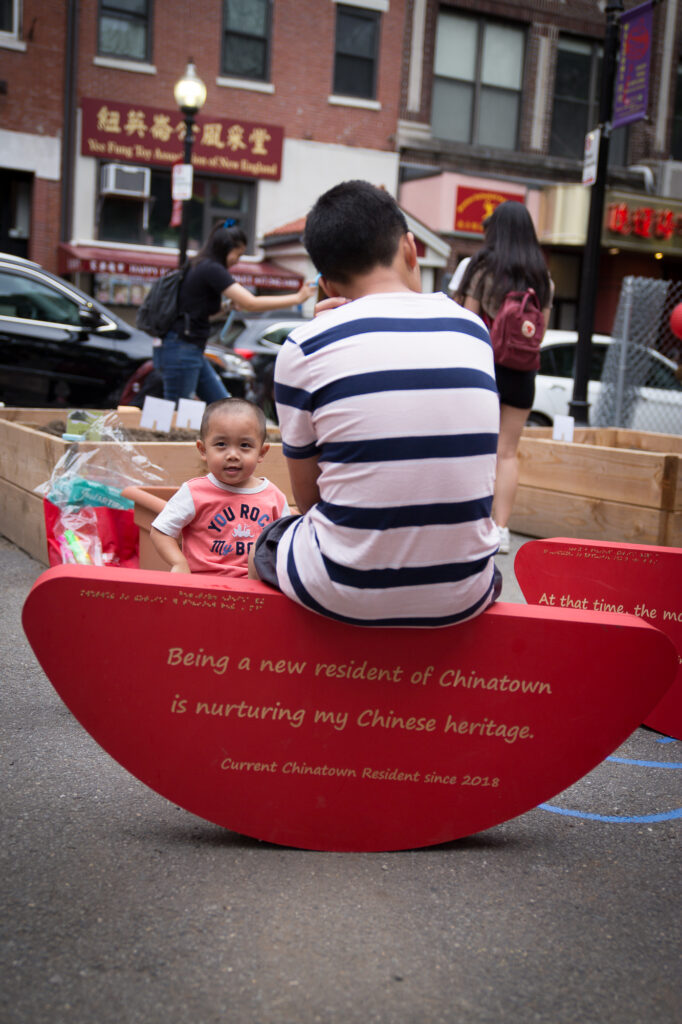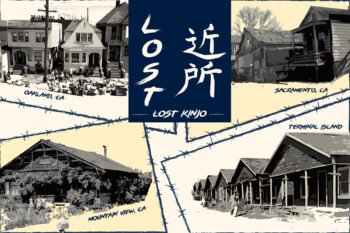By Corrie Martin, AsAmNews Staff Writer
This Friday, August 27th, the last surviving Chinatown in New England invites us to contemplate a brave new future as imagined by a diverse team of artists and local residents who have just completed the Residence Lab, a summer-long arts program.
Nicknamed “ResLab,” the public arts incubator aims “to empower and train artists and residents to collectively preserve the Chinatown community.” Launched in 2019, ResLab is a dynamic experiment in activism, art-making, and community-building inspired by the narratives, peoples, and resilience of the storied Boston, MA neighborhood whose roots reach back to the 1880’s.
An Incubator for the Artist in Everyone
LATEST STORIES
ResLab is the brainchild of two powerhouse Boston Chinatown organizations: Pao Arts Center and the Asian Community Development Corporation (ACDC).
The former is a fledgling cultural and arts hub established in 2017 with the support of the Boston Chinatown Neighborhood Center and nearby Bunker Hill Community College.
Meanwhile, ACDC will soon celebrate a remarkable milestone of 35 years organizing and advocating for affordable housing and a host of quality of life issues for working-class Chinatown residents.
Both organizations have experience employing art–film, music, dance, sculpture, painting, poetry, photography, and more–to convey the richness and complexity of contemporary life in Boston Chinatown, and to combat long-entrenched stereotypes and ignorance of the community’s history and current struggles. And both support artists and art-making as a tangible way to empower Boston Chinatown in its fight to shape its future and cultural identity.
Boston Chinatown: A Community of Care and Creativity
To spark their vision for their art projects, this year’s teams explored a central theme of “collective care” which has deeper resonance since the pandemic has exacerbated existing economic, housing, and health insecurities, as well as anti-Asian violence.
“This year, we have been reminded of the importance of care. Mutual aid, community support networks, and redistribution systems have helped our most vulnerable neighbors weather this pandemic,” visual artist Lily Xie, a ResLab 2019 participating artist who currently serves as the program’s co-facilitator, explained.

The three artist-resident teams stoked their ability to dream big in response to provocative questions such as, “How do we care for and attend to our communities? How can we facilitate more caring relationships between people and public spaces?” and “How can public spaces in Chinatown make residents feel more seen, included, and safe? Finally, “what would our gathering spaces feel and look like if we used them to show community care?”
Xie’s co-facilitator, artist Leslie Anne Condon, is ecstatic about the results, enthusing that, “each of the three installations focus on joy, play, & mutual aid, highlighting the local power and resilience we’ve witnessed throughout Chinatown’s history and especially this past year.”
For Condon, art-making and cultural work of all kinds have been integral to the making and sustaining of AAPI communities over the generations. Condon, the program manager for Pao Arts Center, tells AsAmNews, “During times of crisis, it’s easy for us to forget that our AAPI communities are built upon a long history of grassroots activism, especially through different artistic forms of expression.”
Indeed, the fact that Chinatowns and other Asian community enclaves have always been sites of creativity, aesthetic innovation, and imaginative production is not well-known or often highlighted.
Yet, despite the range, diversity, and sheer quantity of Asian American art production, Chinatowns in particular continue to be stigmatized in the popular imagination as sites of urban blight, inscrutable foreignness, and even disease. At the same time, Chinatown and other Asian communities have always fought back with creativity to counter such racist representations and beliefs.
This year, ResLab has developed three unique projects for temporary installation at the celebrated Mary Soo Hoo Park, a small parcel of precious open space that was renovated and re-dedicated ten years ago to honor the beloved influential Chinatown community leader, one of the founders of ACDC who, until her death in 2005, continued to work tirelessly to safeguard and improve the health, safety, and well-being of the neighborhood.
The pandemic crisis could not quell Boston Chinatown’s creative spirit and drive to fight for its future, a resilience that marks the history of the community since its creation in the late 19th century and that seems to be as strong as ever today.
Asian American Artivism in the Era of Covid

“This resilience has persisted despite the ongoing challenges we continue to face in all areas of society. Residence Lab contributes to that cultural legacy by promoting neighborhood and community wellness through the arts and the power of imagination,” said Condon.
The program also emphasizes the power of art to foment positive social change and to awaken and develop activism and leadership skills. Cynthia Woo, director of Pao Arts Center, explains to AsAmNews, “By creating art you develop a sense of agency and belonging. Such empowerment is the goal of ResLab.”
In fact, as a ResLab 2020 workshop facilitator drove home to participants last year, “Everything we need to change the future is already within us. Some of us have never been told we have super powers and I am here to tell you that you absolutely do.”
The key elements of the ResLab experiment–public art-making, visionary social change, community-based leadership and self-determination–combine to produce an exciting form of artivism.
Art for Art’s Sake
While ResLab embraces the political utility of art for its unique ability to enlarge our political imagination and aspirations, the program’s mission is equally about celebrating art as the manifestation of beauty, emotion, humanity.
Jeena Hah, ACDC’s Director of Community Programs and Design, muses, “there is always this pressure for art to be more than itself, to demand that it serve as a tool to achieve another purpose and to have a value beyond itself. Some ask, does art have practical value? What difference does it make and why should we spend our scarce resources and time on it? But art and art-making have value in themselves. We all need beauty. That in itself has value.”
One former ResLab participating resident, a former journalist in China, learned to think of herself as an artist and discovered that, “art is everywhere and belongs everywhere around me, a part of everyday life and not only a thing that special people do in designated places.”
At the same time, Hah acknowledges, Chinatown residents have a long list of urgent needs around housing, health, childcare, jobs, and more. Still, thinking and working like an artist “trains you to dream big,” she says. “In place of the scarcity mindset that asks what can we afford to do or what can we live with, we develop our capacity for vision, for thinking beyond limitations imposed on us.”
ResLab has an inspiring message for every Asian community fighting for survival and assessing the immediate needs of your neighborhood. Don’t stop there: “Now try to create the best version of that space. What do you see, hear, smell, taste, and feel? How far can you stretch your imagination to dream big?”
A guest workshop facilitator this year, Ponnapa Prakkamakul, a licensed landscape architect at Sasaki who also participated in the 2019 inaugural cohort, describes her experience to AsAmNews:
“I was a little nervous at first working with my team of residents as I was new to the teaching and mentoring role. My aim was for my team to feel ownership over what we were doing and to find confidence and joy in making their own art. In addition to the art work we created, I am really proud that a resident in my cohort discovered a new passion for spray painting that they still enjoy doing!”
The ResLab experience is rewarding for participating artists too, Prakkamakul says. In addition to finding her footing as a mentor, she says that, “In the process I learned a lot about Boston Chinatown as a place of deep connections and histories. I learned so much from the residents themselves who have such profound knowledge and insight about their neighborhood, and from Pao Arts and ACDC about what it takes to practice community engagement that is truly resident-centered.”
This year’s edition, ResLab 2021, culminates with a free, live event beginning at 5pm EST, Friday evening, August 27th, in Mary Soo Hoo Park, adjacent to the iconic Boston Chinatown Gate. After the official kickoff event, the entire ResLab exhibit remains on public display through Saturday, September 25.
Learn more about the program and get updates on the exhibition on the ResLab blog.
Stop by Mary Soo Hoo Park in person or check out the ResLab blog to experience and be inspired by dreams for Boston Chinatown’s future.
Inspired to learn more?
Check out these Chinatown-based projects:
Art, Culture, and Belonging in Chinatown
Asian Arts Initiative: Homepage
Fundraiser to commemorate Pittsburgh’s lost Chinatown – AsAmNews
Examples of Chinatown-based community organizations:
Chinatown Service Center | Non-profit | Los Angeles
Chinese Culture Center of San Francisco
Coalition for a Better Chinese American Community
SCIDpda – Seattle Chinatown International District Preservation Development Authority and Wing Luke Museum
Read Further:
‘American Chinatown’ Through Residents’ Eyes
Chinatowns of New York City by Wendy Wan-Yin Tan
San Francisco Chinatown: A Guide to Its History and Architecture by Philip C. Choy
Interior Chinatown, award-winning novel by Charles Yu
Songs of Gold Mountain: Cantonese Rhymes from San Francisco Chinatown, edited and translated by Marlon K. Hom
AsAmNews has Asian America in its heart. We’re an all-volunteer effort of dedicated staff and interns. Check out our new Instagram account. Go to our Twitter feed and Facebook page for more content. Please consider interning, joining our staff, or submitting a story or making a contribution.








